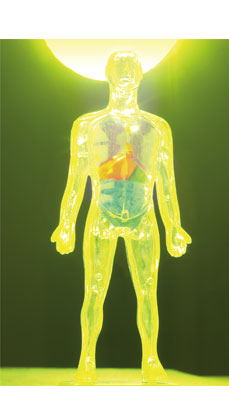




![]()
A team of UGA researchers has demonstrated for the first time a new technique to create tiny “natural motors” that could lead to new methods of drug delivery, disease treatment and bioengineering.
The research, by physicists Yiping Zhao, Yuping He and Jinsong Wu, shows a new way to create catalytic nanomotors, naturally occurring power sources for nanometer-scale machines powered by chemical reactions.
“To make the nanomachine, we first have to make all the different parts, which is the biggest challenge,” said Zhao. “The most important aspect is that we design them to work in specific ways.”
The research was published in the online edition of the American Chemical Society journal Nano Letters.
The tiny machines could one day be used to open constricted or clogged blood vessels too small for conventional stents—or to deliver drugs by drilling through the cell wall of an organism. Zhao sees many other potential uses, including one in which the motors could be designed to exchange, release and deposit different chemicals in the body or elsewhere.
Zhao and his group were able to demonstrate a simple technique to fabricate catalytic nanomotors using a new technique called Dynamic Shadowing Growth. The technique, which modifies existing methods, offers greater flexibility in designing nanomotor structures.
Synthetic nanomotors that use a catalyst to turn the chemical energy into kinetic energy are already commonplace. Until now, however, the range of achievable motion has been limited to linear directions of the submicroscopic metal particles. Zhao used the hundreds of moving parts in an automobile as the context for similarly designing each part of a nanomotor. He wanted to achieve a controlled, flexible range of motion so all the parts work together.
After successfully using the new technique to design nanorods to rotate, Zhao and post-doctoral researcher Yuping He took the process one step further. They broke the symmetry of the rods to form L-shaped rods which could then be aggregated to form larger particles. Then they transformed the rod into a spiral shape so that its rotation would mimic the turning of a drill.
The team used the new technique to deposit a platinum or silver catalyst on different portions of the L-shaped rods, and then designed different experiments to test their ability to control the motion. In a solution of hydrogen peroxide, Zhao and He captured images of the nanorods turning precisely in the directions proscribed by the catalyst depositions.
For more information, contact
Yiping Zhao at zhaoy@phyast.uga.edu
or Yuping He at yphe@physast.uga.edu
For comments or for information please e-mail: rcomm@uga.edu
To contact the webmaster please email: ovprweb@uga.edu
![]()